Competitive Strategy of IKEA: A Case Study in India
VerifiedAdded on 2024/05/31
|12
|2785
|363
AI Summary
This report analyzes the competitive strategy of IKEA, a Swedish-founded, Dutch-based multinational company specializing in ready-to-assemble furniture, home accessories, and kitchen appliances. It examines IKEA's entry into the Indian market, its international corporate-level strategy, and the challenges it faces in this emerging economy. The report also explores the advantages and disadvantages of IKEA's chosen entry mode, Foreign Direct Investment (FDI), and provides recommendations for the company to overcome its challenges and achieve its targets in India.
Contribute Materials
Your contribution can guide someone’s learning journey. Share your
documents today.
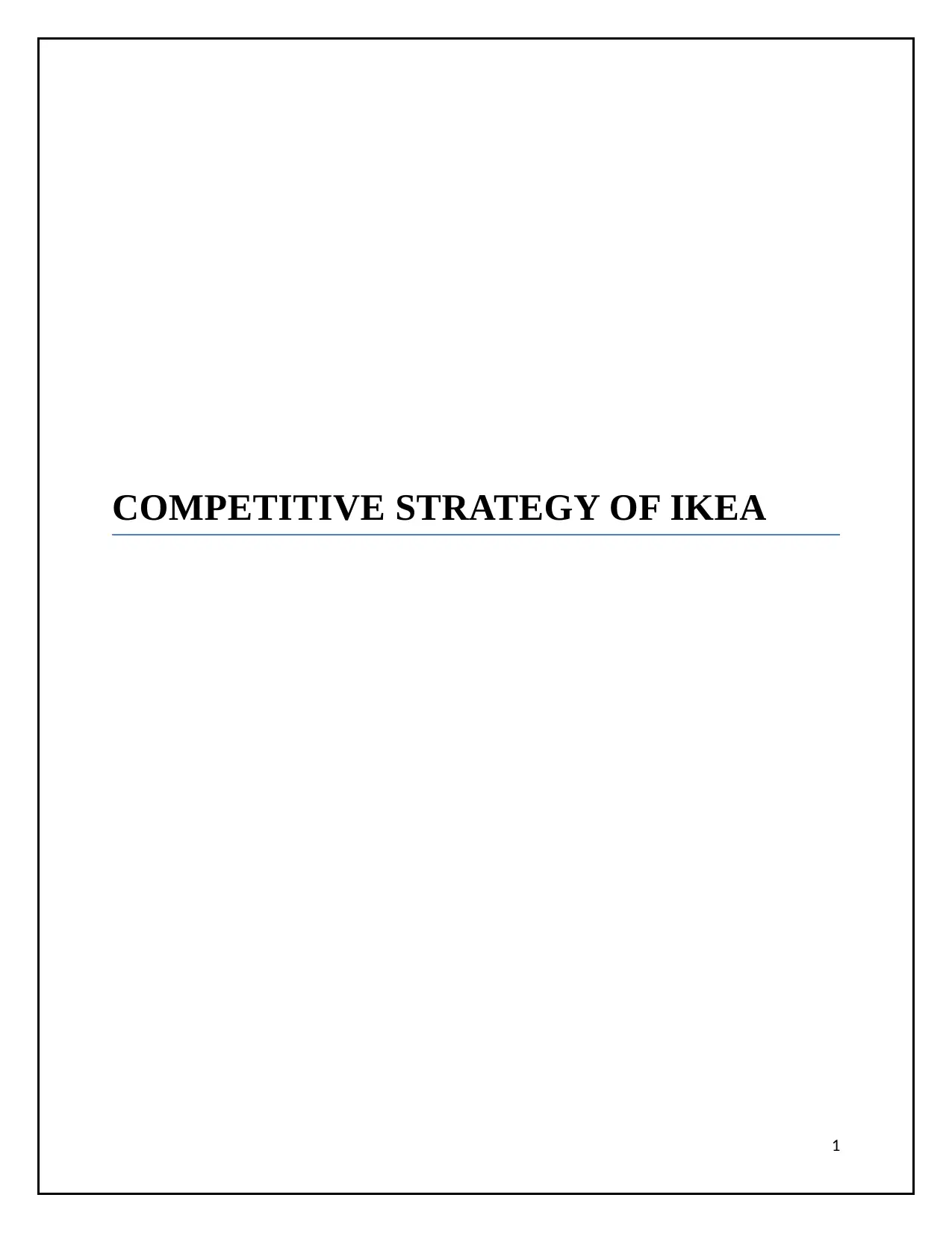
COMPETITIVE STRATEGY OF IKEA
1
1
Secure Best Marks with AI Grader
Need help grading? Try our AI Grader for instant feedback on your assignments.
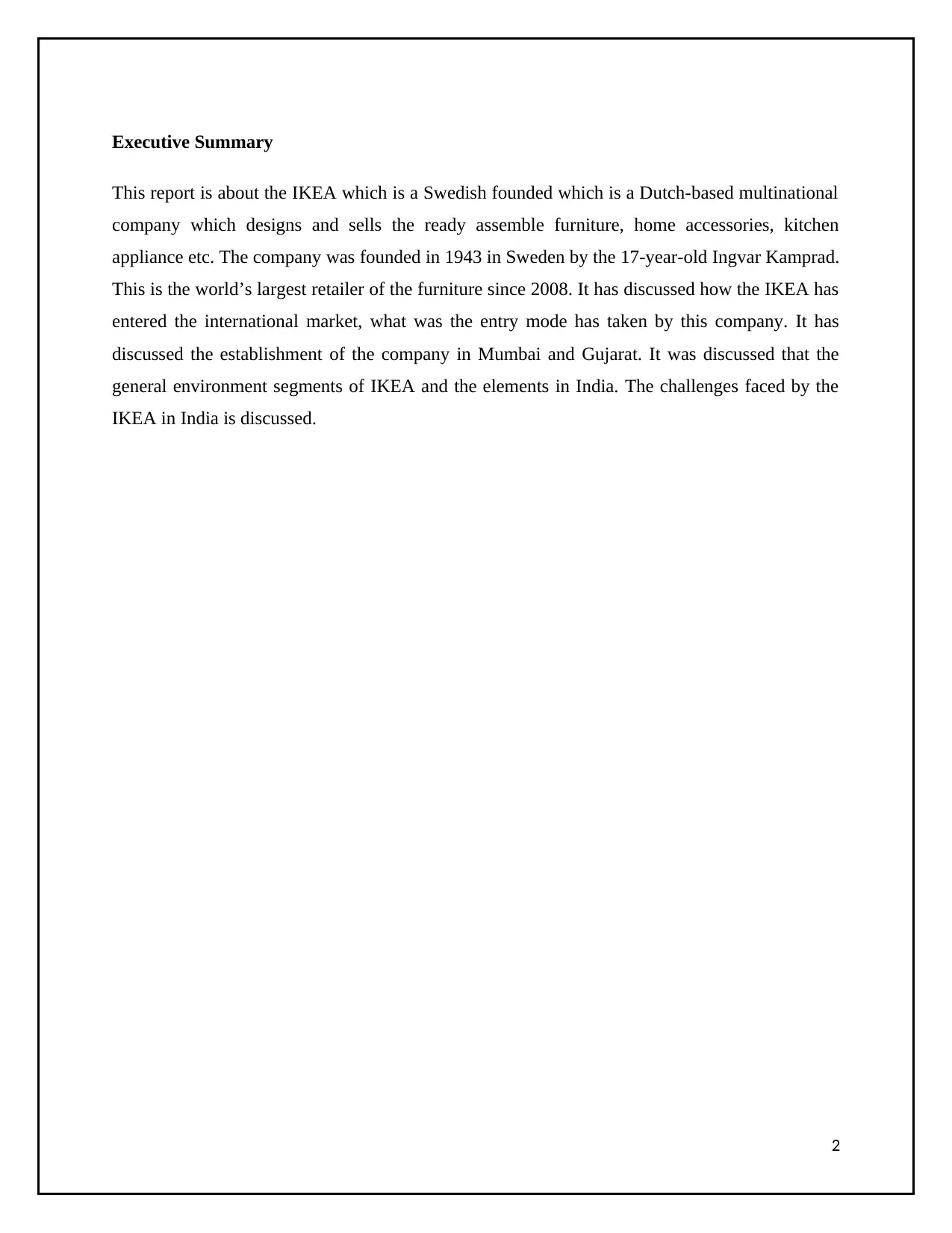
Executive Summary
This report is about the IKEA which is a Swedish founded which is a Dutch-based multinational
company which designs and sells the ready assemble furniture, home accessories, kitchen
appliance etc. The company was founded in 1943 in Sweden by the 17-year-old Ingvar Kamprad.
This is the world’s largest retailer of the furniture since 2008. It has discussed how the IKEA has
entered the international market, what was the entry mode has taken by this company. It has
discussed the establishment of the company in Mumbai and Gujarat. It was discussed that the
general environment segments of IKEA and the elements in India. The challenges faced by the
IKEA in India is discussed.
2
This report is about the IKEA which is a Swedish founded which is a Dutch-based multinational
company which designs and sells the ready assemble furniture, home accessories, kitchen
appliance etc. The company was founded in 1943 in Sweden by the 17-year-old Ingvar Kamprad.
This is the world’s largest retailer of the furniture since 2008. It has discussed how the IKEA has
entered the international market, what was the entry mode has taken by this company. It has
discussed the establishment of the company in Mumbai and Gujarat. It was discussed that the
general environment segments of IKEA and the elements in India. The challenges faced by the
IKEA in India is discussed.
2
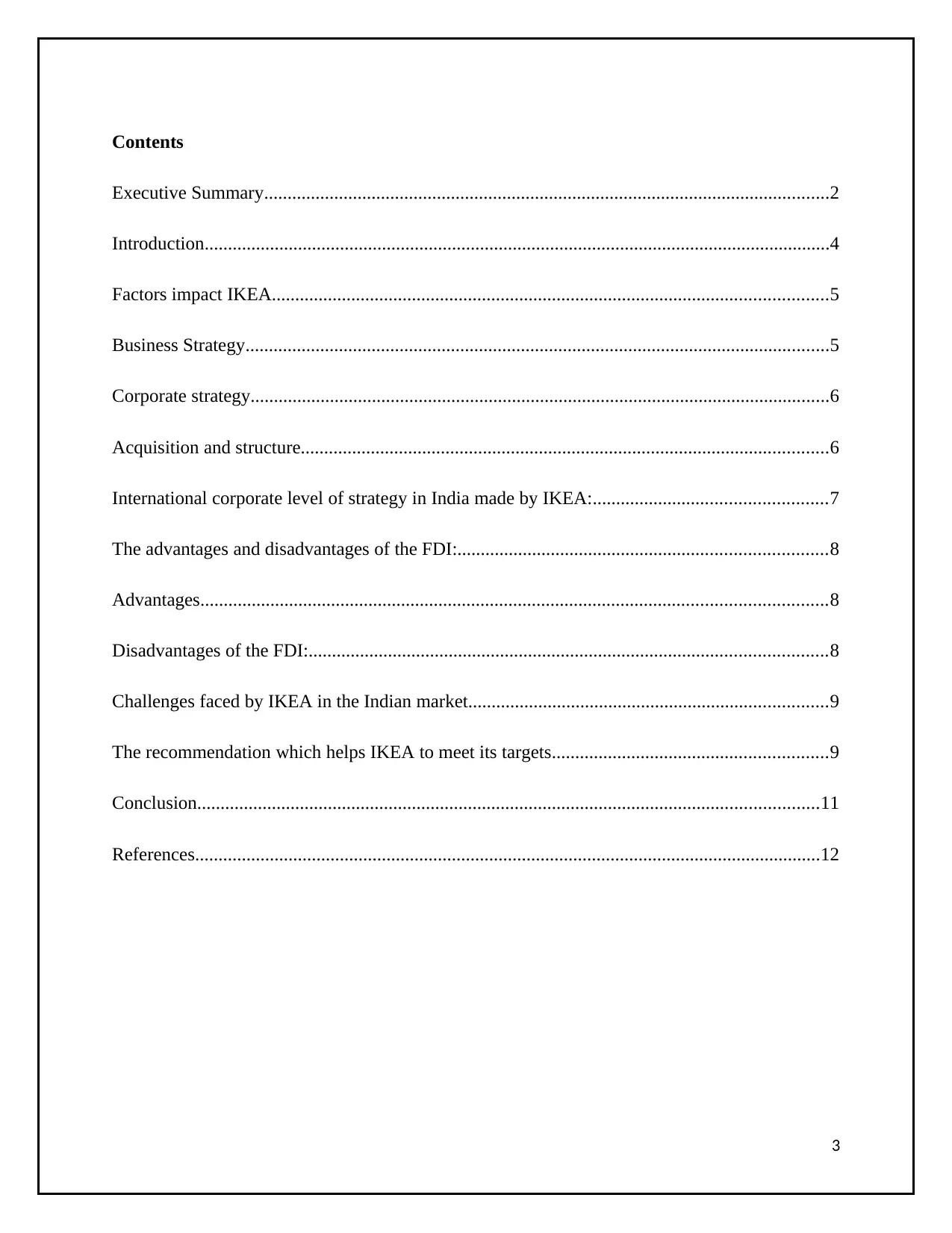
Contents
Executive Summary.........................................................................................................................2
Introduction......................................................................................................................................4
Factors impact IKEA.......................................................................................................................5
Business Strategy.............................................................................................................................5
Corporate strategy............................................................................................................................6
Acquisition and structure.................................................................................................................6
International corporate level of strategy in India made by IKEA:..................................................7
The advantages and disadvantages of the FDI:...............................................................................8
Advantages......................................................................................................................................8
Disadvantages of the FDI:...............................................................................................................8
Challenges faced by IKEA in the Indian market.............................................................................9
The recommendation which helps IKEA to meet its targets...........................................................9
Conclusion.....................................................................................................................................11
References......................................................................................................................................12
3
Executive Summary.........................................................................................................................2
Introduction......................................................................................................................................4
Factors impact IKEA.......................................................................................................................5
Business Strategy.............................................................................................................................5
Corporate strategy............................................................................................................................6
Acquisition and structure.................................................................................................................6
International corporate level of strategy in India made by IKEA:..................................................7
The advantages and disadvantages of the FDI:...............................................................................8
Advantages......................................................................................................................................8
Disadvantages of the FDI:...............................................................................................................8
Challenges faced by IKEA in the Indian market.............................................................................9
The recommendation which helps IKEA to meet its targets...........................................................9
Conclusion.....................................................................................................................................11
References......................................................................................................................................12
3
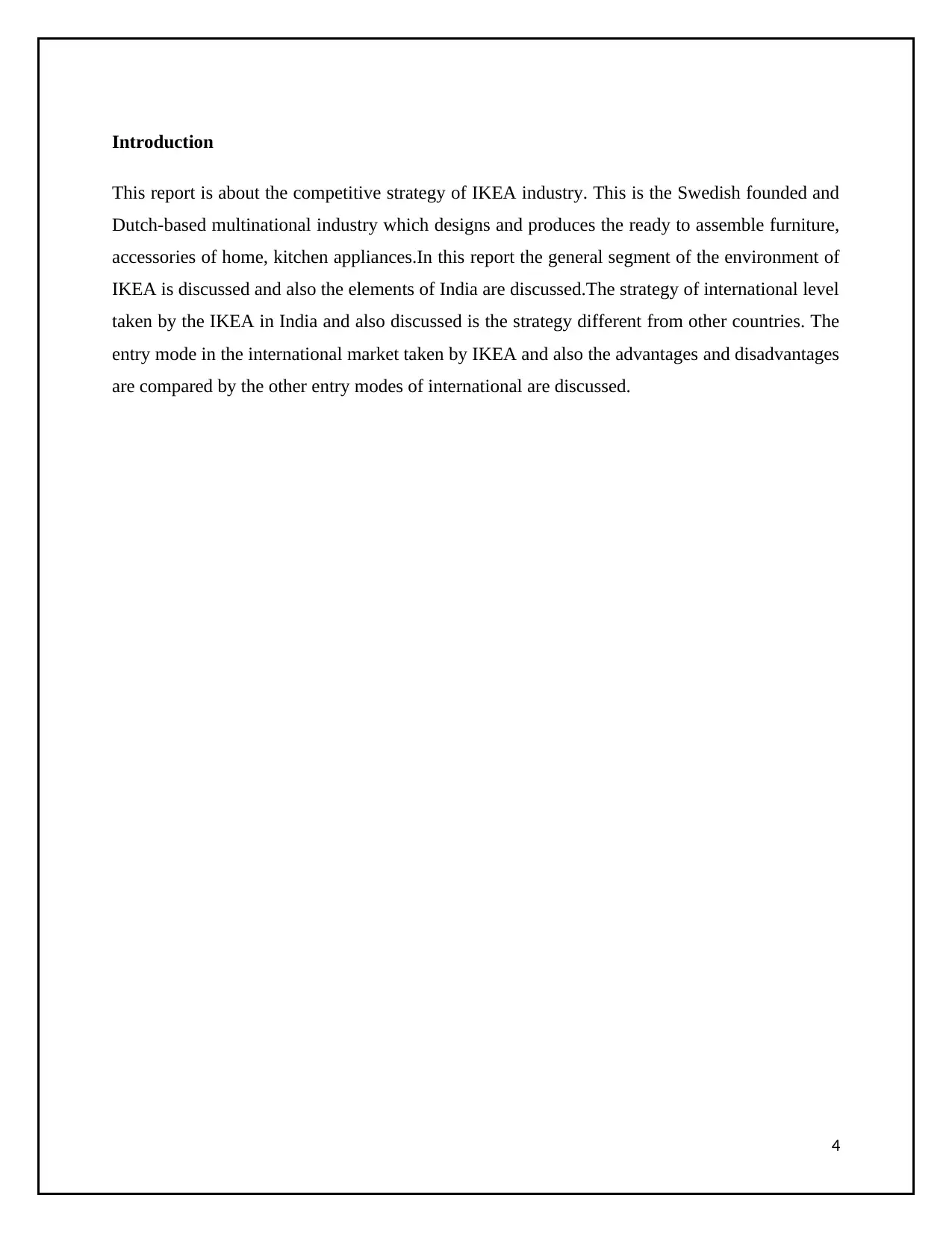
Introduction
This report is about the competitive strategy of IKEA industry. This is the Swedish founded and
Dutch-based multinational industry which designs and produces the ready to assemble furniture,
accessories of home, kitchen appliances.In this report the general segment of the environment of
IKEA is discussed and also the elements of India are discussed.The strategy of international level
taken by the IKEA in India and also discussed is the strategy different from other countries. The
entry mode in the international market taken by IKEA and also the advantages and disadvantages
are compared by the other entry modes of international are discussed.
4
This report is about the competitive strategy of IKEA industry. This is the Swedish founded and
Dutch-based multinational industry which designs and produces the ready to assemble furniture,
accessories of home, kitchen appliances.In this report the general segment of the environment of
IKEA is discussed and also the elements of India are discussed.The strategy of international level
taken by the IKEA in India and also discussed is the strategy different from other countries. The
entry mode in the international market taken by IKEA and also the advantages and disadvantages
are compared by the other entry modes of international are discussed.
4
Secure Best Marks with AI Grader
Need help grading? Try our AI Grader for instant feedback on your assignments.

IKEA was founded in the year 1943 in Sweden by the 17 years Ingvar Kamprad. This is the
Dutch-based multinational company which designs and sells the ready to assemble furniture,
home accessories and kitchen appliances.Ingvar was listed by Forbes in the year 2015 as one of
the 10th richest people in the world. This company is known for the modernist design for many
different types of furniture and appliances (Brown, et. al., 2016). This industry is known for its
cost control attention and continuous product development, details of operations and corporate
attributes which allow IKEA to lower its price. In the year 2017, the company operatesand owns
almost 415 stores in 49 countries. The website of the company contains 12,000 products; there
are almost 2.1 billion visitors on the website of IKEA.IKEA in India if for 30 years, the source
products are approximately € 315 million each year. IKEA had acquired 23-acre land in Mumbai
in 2017 for its second store, this year Mumbai store will have an area of 4,30,000 sq. ft. and also
the investment will of 700crore.
Factors impact IKEA
Factors in the general environment which impact IKEA are, the first factor is Demographic
which can easily understand the elements of the environment. IKEA targets the middle class
globally which are indirectly related to the buying. IKEA was the typical shopper who likes
taking the risk, travel abroad and also the early adopter of the technology of consumer such as
laptops, walkmen. Socio-culture influences the lifestyle of society, values, beliefs; IKEA
adopted the natural step framework which was the basic structure of its environmental plans
(Löfgren, 2015). IKEA made many changes in its services and products. Political processes
influence the regulation of the environment. IKEA face the environment which causes that IKEA
needs to change its business structure.
Business Strategy
There are different Strategies made by IKEA in India are low-cost leadership strategy, product
strategy, promotion strategy, market development strategy. Low-cost leadership strategy,
IKEA has the unique model of business which connects the customer’s need which is possible on
the floor of the factory. The company develops its product in its own factory; the main point for
the development of the product is the price. The company makes the possible in the production
5
Dutch-based multinational company which designs and sells the ready to assemble furniture,
home accessories and kitchen appliances.Ingvar was listed by Forbes in the year 2015 as one of
the 10th richest people in the world. This company is known for the modernist design for many
different types of furniture and appliances (Brown, et. al., 2016). This industry is known for its
cost control attention and continuous product development, details of operations and corporate
attributes which allow IKEA to lower its price. In the year 2017, the company operatesand owns
almost 415 stores in 49 countries. The website of the company contains 12,000 products; there
are almost 2.1 billion visitors on the website of IKEA.IKEA in India if for 30 years, the source
products are approximately € 315 million each year. IKEA had acquired 23-acre land in Mumbai
in 2017 for its second store, this year Mumbai store will have an area of 4,30,000 sq. ft. and also
the investment will of 700crore.
Factors impact IKEA
Factors in the general environment which impact IKEA are, the first factor is Demographic
which can easily understand the elements of the environment. IKEA targets the middle class
globally which are indirectly related to the buying. IKEA was the typical shopper who likes
taking the risk, travel abroad and also the early adopter of the technology of consumer such as
laptops, walkmen. Socio-culture influences the lifestyle of society, values, beliefs; IKEA
adopted the natural step framework which was the basic structure of its environmental plans
(Löfgren, 2015). IKEA made many changes in its services and products. Political processes
influence the regulation of the environment. IKEA face the environment which causes that IKEA
needs to change its business structure.
Business Strategy
There are different Strategies made by IKEA in India are low-cost leadership strategy, product
strategy, promotion strategy, market development strategy. Low-cost leadership strategy,
IKEA has the unique model of business which connects the customer’s need which is possible on
the floor of the factory. The company develops its product in its own factory; the main point for
the development of the product is the price. The company makes the possible in the production
5
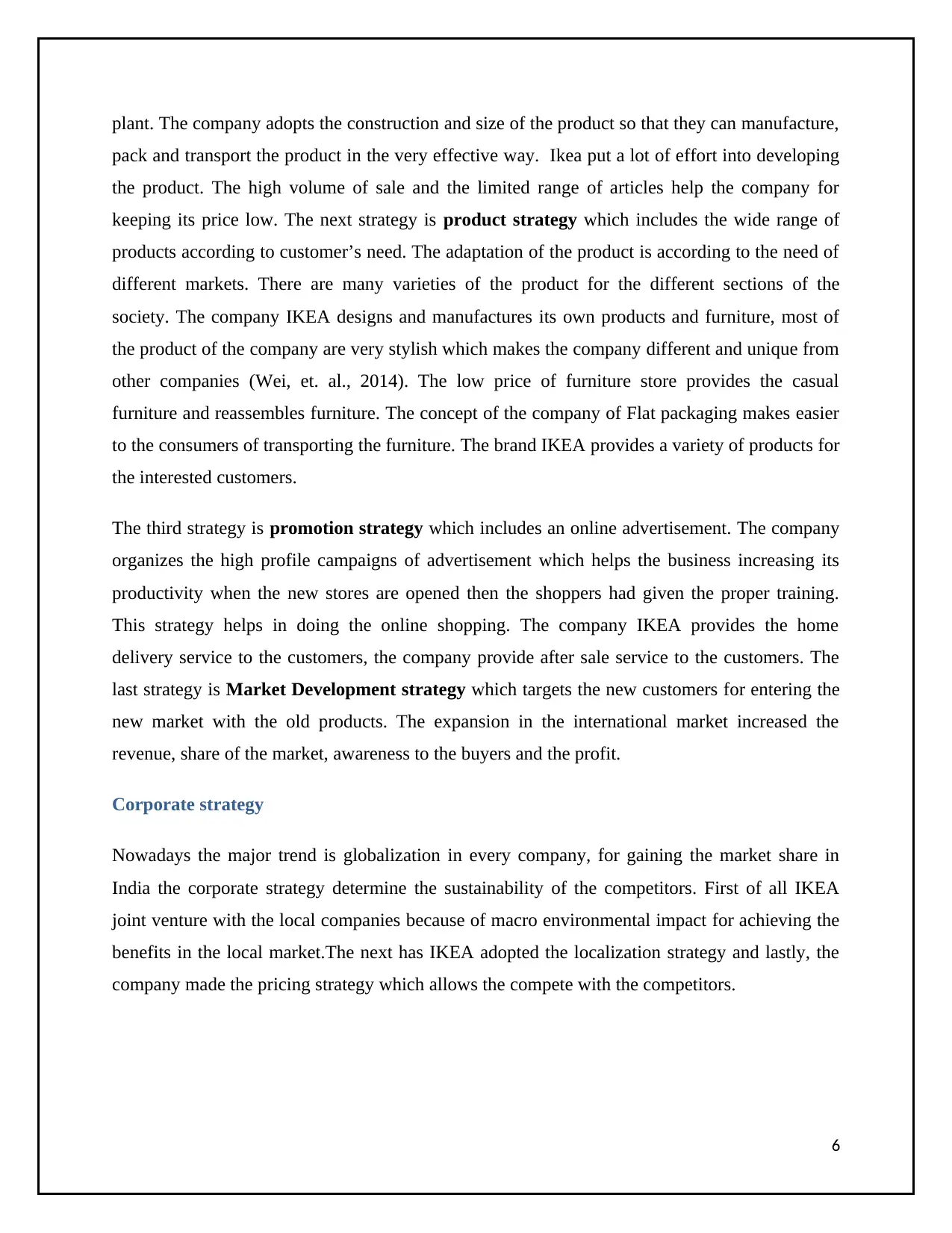
plant. The company adopts the construction and size of the product so that they can manufacture,
pack and transport the product in the very effective way. Ikea put a lot of effort into developing
the product. The high volume of sale and the limited range of articles help the company for
keeping its price low. The next strategy is product strategy which includes the wide range of
products according to customer’s need. The adaptation of the product is according to the need of
different markets. There are many varieties of the product for the different sections of the
society. The company IKEA designs and manufactures its own products and furniture, most of
the product of the company are very stylish which makes the company different and unique from
other companies (Wei, et. al., 2014). The low price of furniture store provides the casual
furniture and reassembles furniture. The concept of the company of Flat packaging makes easier
to the consumers of transporting the furniture. The brand IKEA provides a variety of products for
the interested customers.
The third strategy is promotion strategy which includes an online advertisement. The company
organizes the high profile campaigns of advertisement which helps the business increasing its
productivity when the new stores are opened then the shoppers had given the proper training.
This strategy helps in doing the online shopping. The company IKEA provides the home
delivery service to the customers, the company provide after sale service to the customers. The
last strategy is Market Development strategy which targets the new customers for entering the
new market with the old products. The expansion in the international market increased the
revenue, share of the market, awareness to the buyers and the profit.
Corporate strategy
Nowadays the major trend is globalization in every company, for gaining the market share in
India the corporate strategy determine the sustainability of the competitors. First of all IKEA
joint venture with the local companies because of macro environmental impact for achieving the
benefits in the local market.The next has IKEA adopted the localization strategy and lastly, the
company made the pricing strategy which allows the compete with the competitors.
6
pack and transport the product in the very effective way. Ikea put a lot of effort into developing
the product. The high volume of sale and the limited range of articles help the company for
keeping its price low. The next strategy is product strategy which includes the wide range of
products according to customer’s need. The adaptation of the product is according to the need of
different markets. There are many varieties of the product for the different sections of the
society. The company IKEA designs and manufactures its own products and furniture, most of
the product of the company are very stylish which makes the company different and unique from
other companies (Wei, et. al., 2014). The low price of furniture store provides the casual
furniture and reassembles furniture. The concept of the company of Flat packaging makes easier
to the consumers of transporting the furniture. The brand IKEA provides a variety of products for
the interested customers.
The third strategy is promotion strategy which includes an online advertisement. The company
organizes the high profile campaigns of advertisement which helps the business increasing its
productivity when the new stores are opened then the shoppers had given the proper training.
This strategy helps in doing the online shopping. The company IKEA provides the home
delivery service to the customers, the company provide after sale service to the customers. The
last strategy is Market Development strategy which targets the new customers for entering the
new market with the old products. The expansion in the international market increased the
revenue, share of the market, awareness to the buyers and the profit.
Corporate strategy
Nowadays the major trend is globalization in every company, for gaining the market share in
India the corporate strategy determine the sustainability of the competitors. First of all IKEA
joint venture with the local companies because of macro environmental impact for achieving the
benefits in the local market.The next has IKEA adopted the localization strategy and lastly, the
company made the pricing strategy which allows the compete with the competitors.
6
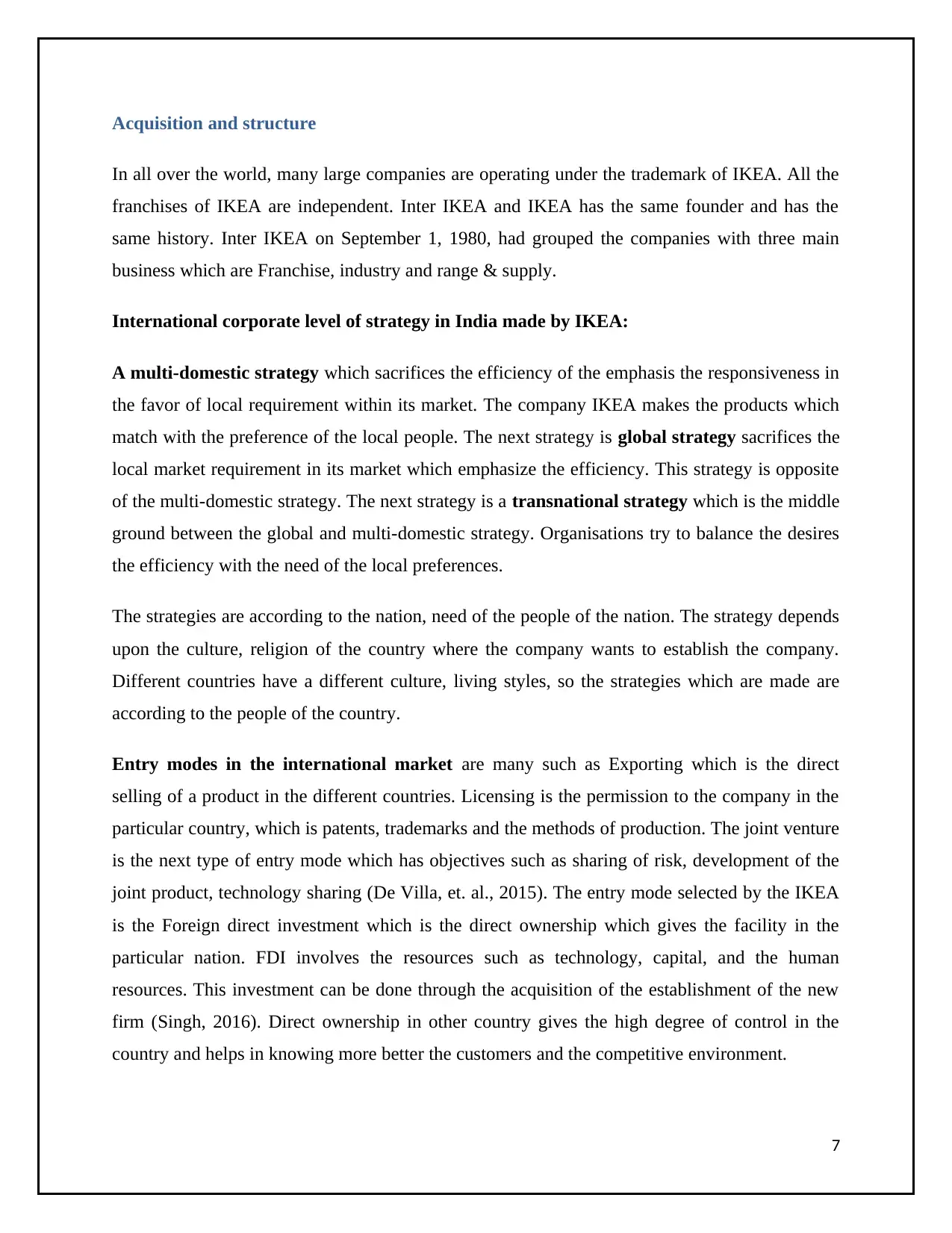
Acquisition and structure
In all over the world, many large companies are operating under the trademark of IKEA. All the
franchises of IKEA are independent. Inter IKEA and IKEA has the same founder and has the
same history. Inter IKEA on September 1, 1980, had grouped the companies with three main
business which are Franchise, industry and range & supply.
International corporate level of strategy in India made by IKEA:
A multi-domestic strategy which sacrifices the efficiency of the emphasis the responsiveness in
the favor of local requirement within its market. The company IKEA makes the products which
match with the preference of the local people. The next strategy is global strategy sacrifices the
local market requirement in its market which emphasize the efficiency. This strategy is opposite
of the multi-domestic strategy. The next strategy is a transnational strategy which is the middle
ground between the global and multi-domestic strategy. Organisations try to balance the desires
the efficiency with the need of the local preferences.
The strategies are according to the nation, need of the people of the nation. The strategy depends
upon the culture, religion of the country where the company wants to establish the company.
Different countries have a different culture, living styles, so the strategies which are made are
according to the people of the country.
Entry modes in the international market are many such as Exporting which is the direct
selling of a product in the different countries. Licensing is the permission to the company in the
particular country, which is patents, trademarks and the methods of production. The joint venture
is the next type of entry mode which has objectives such as sharing of risk, development of the
joint product, technology sharing (De Villa, et. al., 2015). The entry mode selected by the IKEA
is the Foreign direct investment which is the direct ownership which gives the facility in the
particular nation. FDI involves the resources such as technology, capital, and the human
resources. This investment can be done through the acquisition of the establishment of the new
firm (Singh, 2016). Direct ownership in other country gives the high degree of control in the
country and helps in knowing more better the customers and the competitive environment.
7
In all over the world, many large companies are operating under the trademark of IKEA. All the
franchises of IKEA are independent. Inter IKEA and IKEA has the same founder and has the
same history. Inter IKEA on September 1, 1980, had grouped the companies with three main
business which are Franchise, industry and range & supply.
International corporate level of strategy in India made by IKEA:
A multi-domestic strategy which sacrifices the efficiency of the emphasis the responsiveness in
the favor of local requirement within its market. The company IKEA makes the products which
match with the preference of the local people. The next strategy is global strategy sacrifices the
local market requirement in its market which emphasize the efficiency. This strategy is opposite
of the multi-domestic strategy. The next strategy is a transnational strategy which is the middle
ground between the global and multi-domestic strategy. Organisations try to balance the desires
the efficiency with the need of the local preferences.
The strategies are according to the nation, need of the people of the nation. The strategy depends
upon the culture, religion of the country where the company wants to establish the company.
Different countries have a different culture, living styles, so the strategies which are made are
according to the people of the country.
Entry modes in the international market are many such as Exporting which is the direct
selling of a product in the different countries. Licensing is the permission to the company in the
particular country, which is patents, trademarks and the methods of production. The joint venture
is the next type of entry mode which has objectives such as sharing of risk, development of the
joint product, technology sharing (De Villa, et. al., 2015). The entry mode selected by the IKEA
is the Foreign direct investment which is the direct ownership which gives the facility in the
particular nation. FDI involves the resources such as technology, capital, and the human
resources. This investment can be done through the acquisition of the establishment of the new
firm (Singh, 2016). Direct ownership in other country gives the high degree of control in the
country and helps in knowing more better the customers and the competitive environment.
7
Paraphrase This Document
Need a fresh take? Get an instant paraphrase of this document with our AI Paraphraser
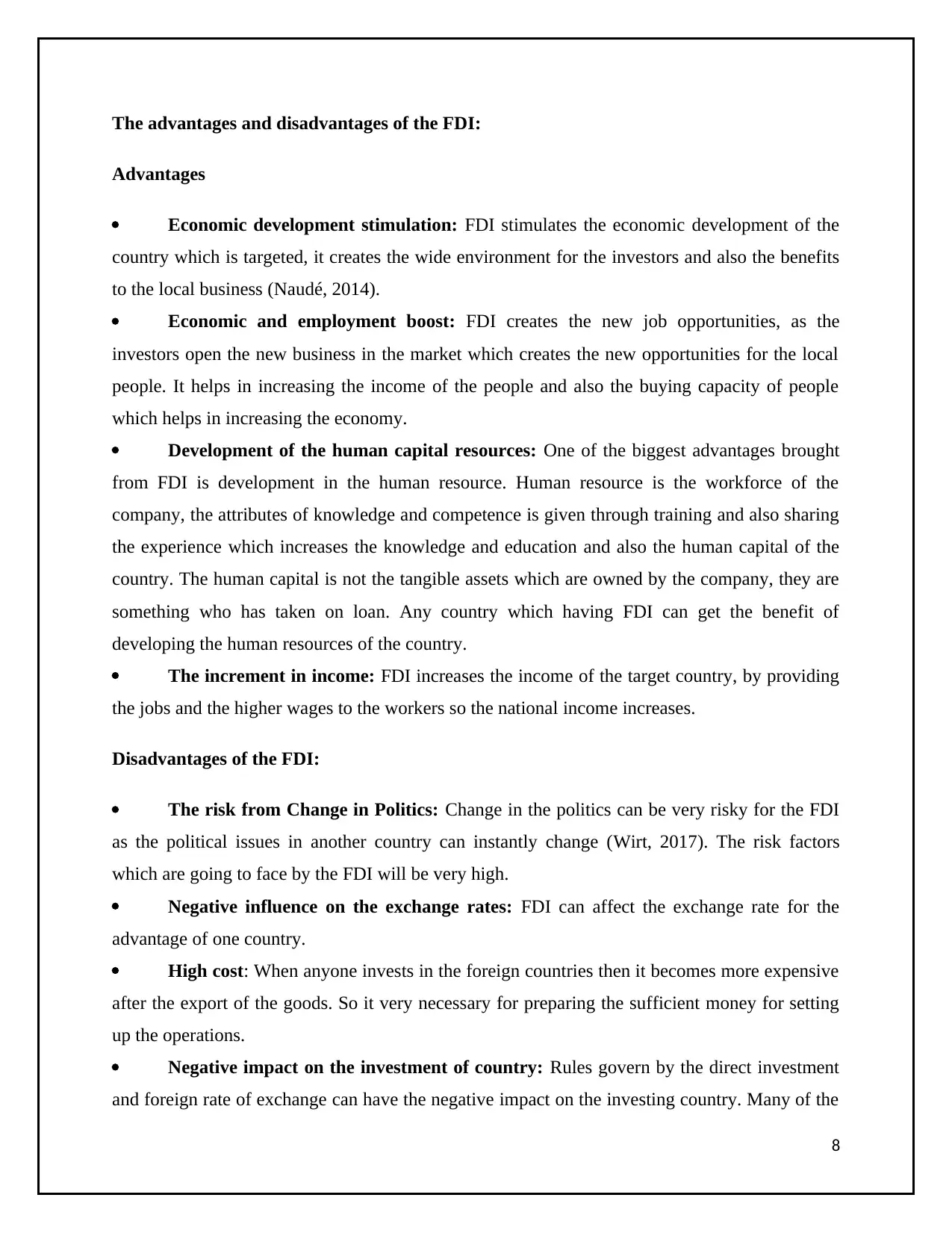
The advantages and disadvantages of the FDI:
Advantages
Economic development stimulation: FDI stimulates the economic development of the
country which is targeted, it creates the wide environment for the investors and also the benefits
to the local business (Naudé, 2014).
Economic and employment boost: FDI creates the new job opportunities, as the
investors open the new business in the market which creates the new opportunities for the local
people. It helps in increasing the income of the people and also the buying capacity of people
which helps in increasing the economy.
Development of the human capital resources: One of the biggest advantages brought
from FDI is development in the human resource. Human resource is the workforce of the
company, the attributes of knowledge and competence is given through training and also sharing
the experience which increases the knowledge and education and also the human capital of the
country. The human capital is not the tangible assets which are owned by the company, they are
something who has taken on loan. Any country which having FDI can get the benefit of
developing the human resources of the country.
The increment in income: FDI increases the income of the target country, by providing
the jobs and the higher wages to the workers so the national income increases.
Disadvantages of the FDI:
The risk from Change in Politics: Change in the politics can be very risky for the FDI
as the political issues in another country can instantly change (Wirt, 2017). The risk factors
which are going to face by the FDI will be very high.
Negative influence on the exchange rates: FDI can affect the exchange rate for the
advantage of one country.
High cost: When anyone invests in the foreign countries then it becomes more expensive
after the export of the goods. So it very necessary for preparing the sufficient money for setting
up the operations.
Negative impact on the investment of country: Rules govern by the direct investment
and foreign rate of exchange can have the negative impact on the investing country. Many of the
8
Advantages
Economic development stimulation: FDI stimulates the economic development of the
country which is targeted, it creates the wide environment for the investors and also the benefits
to the local business (Naudé, 2014).
Economic and employment boost: FDI creates the new job opportunities, as the
investors open the new business in the market which creates the new opportunities for the local
people. It helps in increasing the income of the people and also the buying capacity of people
which helps in increasing the economy.
Development of the human capital resources: One of the biggest advantages brought
from FDI is development in the human resource. Human resource is the workforce of the
company, the attributes of knowledge and competence is given through training and also sharing
the experience which increases the knowledge and education and also the human capital of the
country. The human capital is not the tangible assets which are owned by the company, they are
something who has taken on loan. Any country which having FDI can get the benefit of
developing the human resources of the country.
The increment in income: FDI increases the income of the target country, by providing
the jobs and the higher wages to the workers so the national income increases.
Disadvantages of the FDI:
The risk from Change in Politics: Change in the politics can be very risky for the FDI
as the political issues in another country can instantly change (Wirt, 2017). The risk factors
which are going to face by the FDI will be very high.
Negative influence on the exchange rates: FDI can affect the exchange rate for the
advantage of one country.
High cost: When anyone invests in the foreign countries then it becomes more expensive
after the export of the goods. So it very necessary for preparing the sufficient money for setting
up the operations.
Negative impact on the investment of country: Rules govern by the direct investment
and foreign rate of exchange can have the negative impact on the investing country. Many of the
8
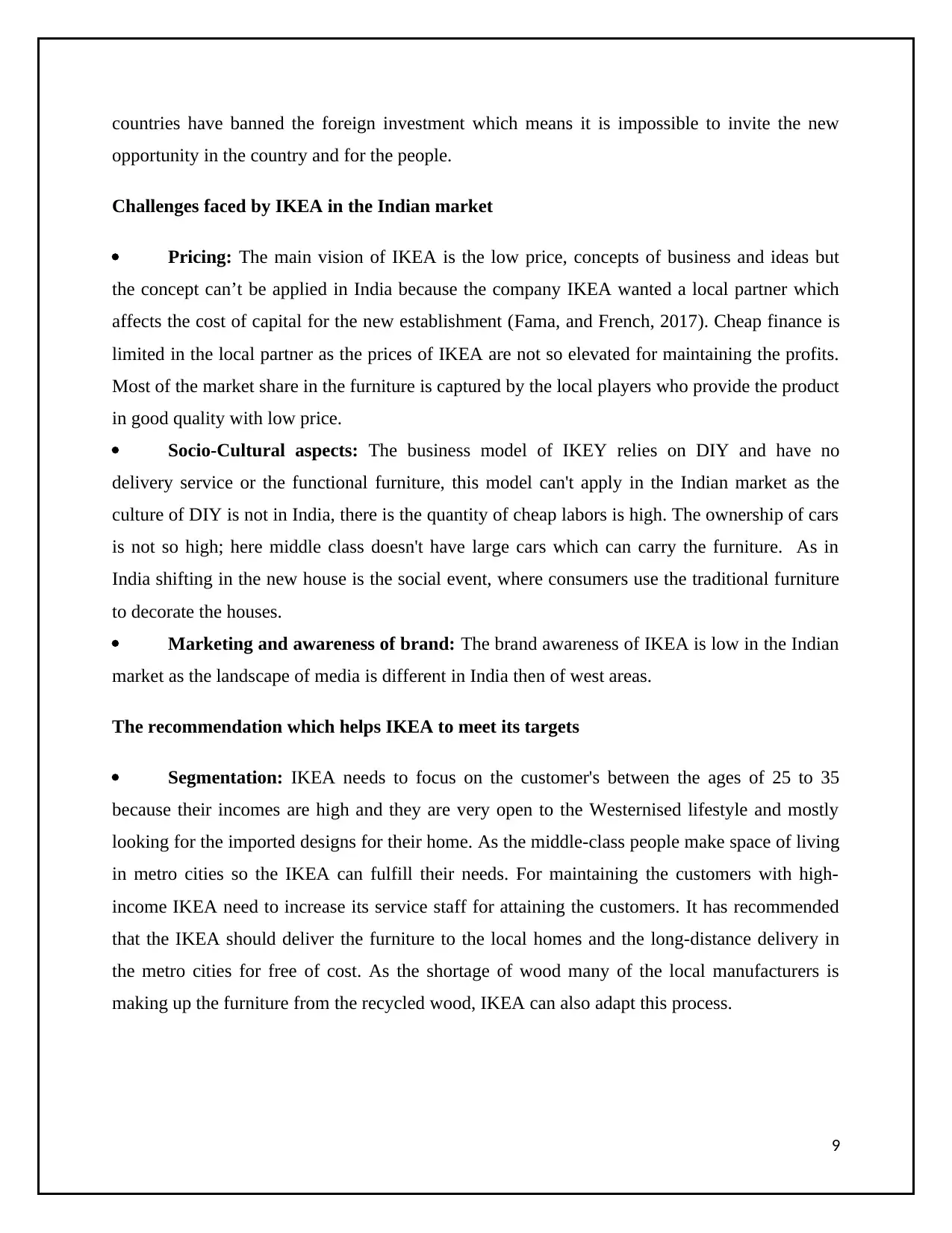
countries have banned the foreign investment which means it is impossible to invite the new
opportunity in the country and for the people.
Challenges faced by IKEA in the Indian market
Pricing: The main vision of IKEA is the low price, concepts of business and ideas but
the concept can’t be applied in India because the company IKEA wanted a local partner which
affects the cost of capital for the new establishment (Fama, and French, 2017). Cheap finance is
limited in the local partner as the prices of IKEA are not so elevated for maintaining the profits.
Most of the market share in the furniture is captured by the local players who provide the product
in good quality with low price.
Socio-Cultural aspects: The business model of IKEY relies on DIY and have no
delivery service or the functional furniture, this model can't apply in the Indian market as the
culture of DIY is not in India, there is the quantity of cheap labors is high. The ownership of cars
is not so high; here middle class doesn't have large cars which can carry the furniture. As in
India shifting in the new house is the social event, where consumers use the traditional furniture
to decorate the houses.
Marketing and awareness of brand: The brand awareness of IKEA is low in the Indian
market as the landscape of media is different in India then of west areas.
The recommendation which helps IKEA to meet its targets
Segmentation: IKEA needs to focus on the customer's between the ages of 25 to 35
because their incomes are high and they are very open to the Westernised lifestyle and mostly
looking for the imported designs for their home. As the middle-class people make space of living
in metro cities so the IKEA can fulfill their needs. For maintaining the customers with high-
income IKEA need to increase its service staff for attaining the customers. It has recommended
that the IKEA should deliver the furniture to the local homes and the long-distance delivery in
the metro cities for free of cost. As the shortage of wood many of the local manufacturers is
making up the furniture from the recycled wood, IKEA can also adapt this process.
9
opportunity in the country and for the people.
Challenges faced by IKEA in the Indian market
Pricing: The main vision of IKEA is the low price, concepts of business and ideas but
the concept can’t be applied in India because the company IKEA wanted a local partner which
affects the cost of capital for the new establishment (Fama, and French, 2017). Cheap finance is
limited in the local partner as the prices of IKEA are not so elevated for maintaining the profits.
Most of the market share in the furniture is captured by the local players who provide the product
in good quality with low price.
Socio-Cultural aspects: The business model of IKEY relies on DIY and have no
delivery service or the functional furniture, this model can't apply in the Indian market as the
culture of DIY is not in India, there is the quantity of cheap labors is high. The ownership of cars
is not so high; here middle class doesn't have large cars which can carry the furniture. As in
India shifting in the new house is the social event, where consumers use the traditional furniture
to decorate the houses.
Marketing and awareness of brand: The brand awareness of IKEA is low in the Indian
market as the landscape of media is different in India then of west areas.
The recommendation which helps IKEA to meet its targets
Segmentation: IKEA needs to focus on the customer's between the ages of 25 to 35
because their incomes are high and they are very open to the Westernised lifestyle and mostly
looking for the imported designs for their home. As the middle-class people make space of living
in metro cities so the IKEA can fulfill their needs. For maintaining the customers with high-
income IKEA need to increase its service staff for attaining the customers. It has recommended
that the IKEA should deliver the furniture to the local homes and the long-distance delivery in
the metro cities for free of cost. As the shortage of wood many of the local manufacturers is
making up the furniture from the recycled wood, IKEA can also adapt this process.
9
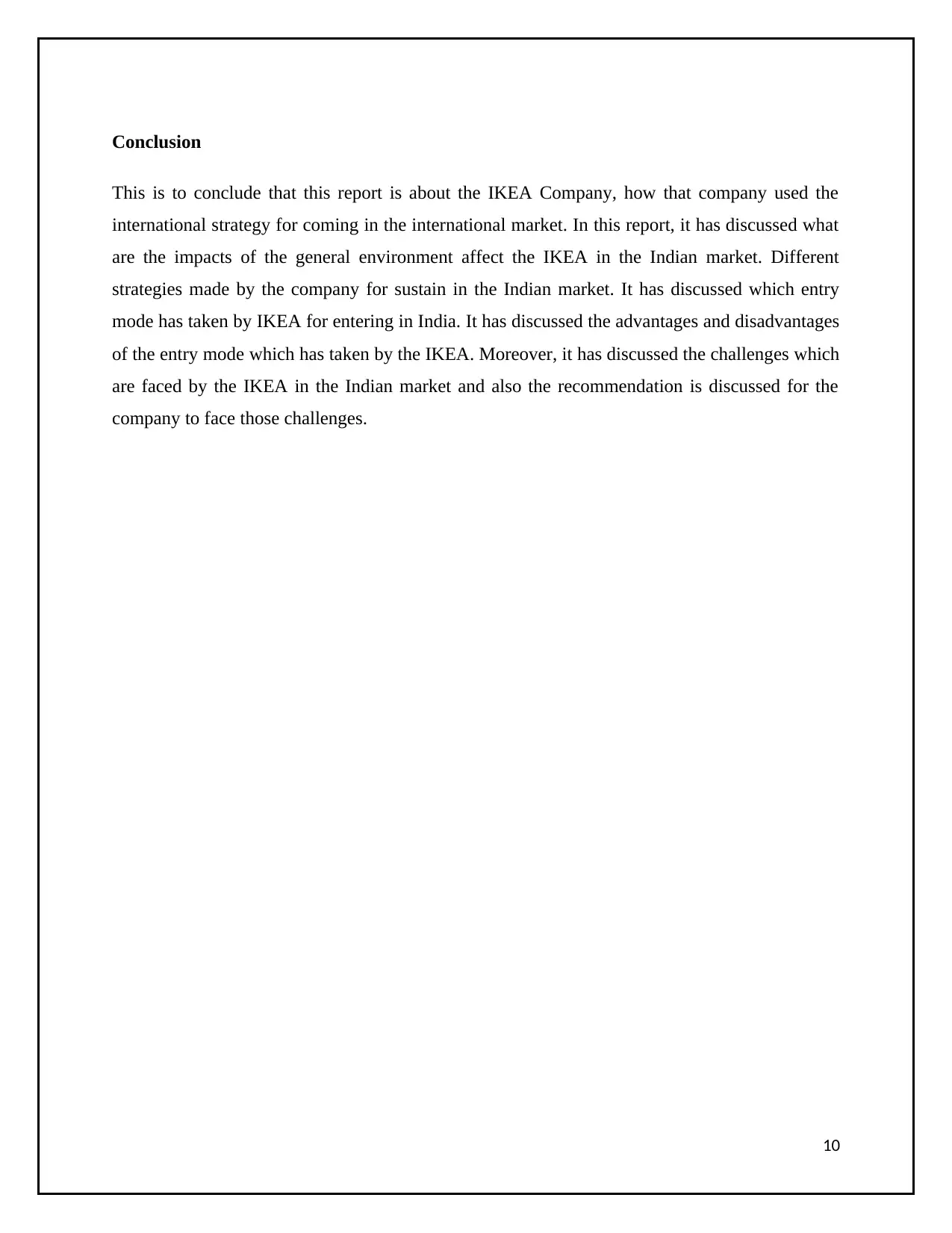
Conclusion
This is to conclude that this report is about the IKEA Company, how that company used the
international strategy for coming in the international market. In this report, it has discussed what
are the impacts of the general environment affect the IKEA in the Indian market. Different
strategies made by the company for sustain in the Indian market. It has discussed which entry
mode has taken by IKEA for entering in India. It has discussed the advantages and disadvantages
of the entry mode which has taken by the IKEA. Moreover, it has discussed the challenges which
are faced by the IKEA in the Indian market and also the recommendation is discussed for the
company to face those challenges.
10
This is to conclude that this report is about the IKEA Company, how that company used the
international strategy for coming in the international market. In this report, it has discussed what
are the impacts of the general environment affect the IKEA in the Indian market. Different
strategies made by the company for sustain in the Indian market. It has discussed which entry
mode has taken by IKEA for entering in India. It has discussed the advantages and disadvantages
of the entry mode which has taken by the IKEA. Moreover, it has discussed the challenges which
are faced by the IKEA in the Indian market and also the recommendation is discussed for the
company to face those challenges.
10
Secure Best Marks with AI Grader
Need help grading? Try our AI Grader for instant feedback on your assignments.
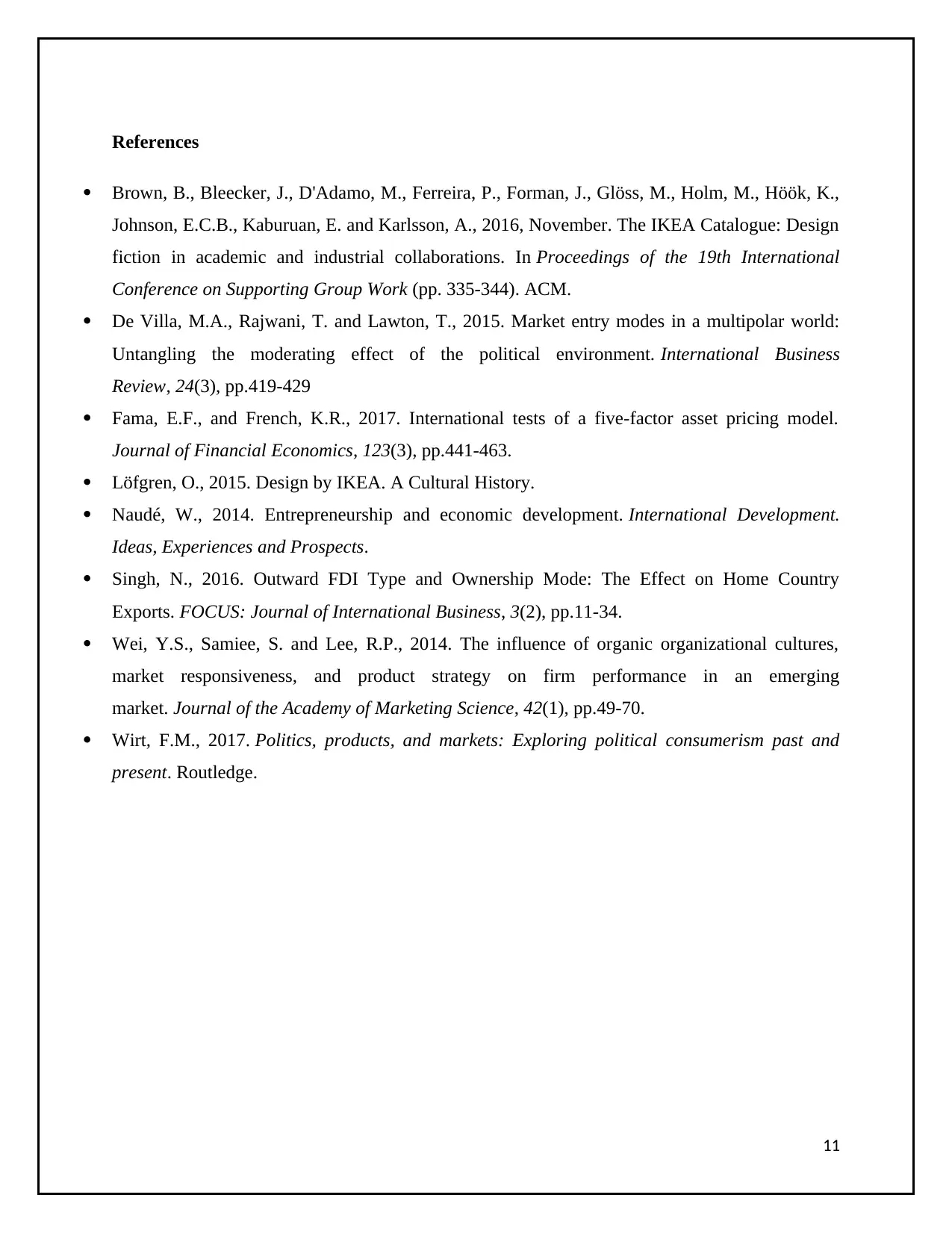
References
Brown, B., Bleecker, J., D'Adamo, M., Ferreira, P., Forman, J., Glöss, M., Holm, M., Höök, K.,
Johnson, E.C.B., Kaburuan, E. and Karlsson, A., 2016, November. The IKEA Catalogue: Design
fiction in academic and industrial collaborations. In Proceedings of the 19th International
Conference on Supporting Group Work (pp. 335-344). ACM.
De Villa, M.A., Rajwani, T. and Lawton, T., 2015. Market entry modes in a multipolar world:
Untangling the moderating effect of the political environment. International Business
Review, 24(3), pp.419-429
Fama, E.F., and French, K.R., 2017. International tests of a five-factor asset pricing model.
Journal of Financial Economics, 123(3), pp.441-463.
Löfgren, O., 2015. Design by IKEA. A Cultural History.
Naudé, W., 2014. Entrepreneurship and economic development. International Development.
Ideas, Experiences and Prospects.
Singh, N., 2016. Outward FDI Type and Ownership Mode: The Effect on Home Country
Exports. FOCUS: Journal of International Business, 3(2), pp.11-34.
Wei, Y.S., Samiee, S. and Lee, R.P., 2014. The influence of organic organizational cultures,
market responsiveness, and product strategy on firm performance in an emerging
market. Journal of the Academy of Marketing Science, 42(1), pp.49-70.
Wirt, F.M., 2017. Politics, products, and markets: Exploring political consumerism past and
present. Routledge.
11
Brown, B., Bleecker, J., D'Adamo, M., Ferreira, P., Forman, J., Glöss, M., Holm, M., Höök, K.,
Johnson, E.C.B., Kaburuan, E. and Karlsson, A., 2016, November. The IKEA Catalogue: Design
fiction in academic and industrial collaborations. In Proceedings of the 19th International
Conference on Supporting Group Work (pp. 335-344). ACM.
De Villa, M.A., Rajwani, T. and Lawton, T., 2015. Market entry modes in a multipolar world:
Untangling the moderating effect of the political environment. International Business
Review, 24(3), pp.419-429
Fama, E.F., and French, K.R., 2017. International tests of a five-factor asset pricing model.
Journal of Financial Economics, 123(3), pp.441-463.
Löfgren, O., 2015. Design by IKEA. A Cultural History.
Naudé, W., 2014. Entrepreneurship and economic development. International Development.
Ideas, Experiences and Prospects.
Singh, N., 2016. Outward FDI Type and Ownership Mode: The Effect on Home Country
Exports. FOCUS: Journal of International Business, 3(2), pp.11-34.
Wei, Y.S., Samiee, S. and Lee, R.P., 2014. The influence of organic organizational cultures,
market responsiveness, and product strategy on firm performance in an emerging
market. Journal of the Academy of Marketing Science, 42(1), pp.49-70.
Wirt, F.M., 2017. Politics, products, and markets: Exploring political consumerism past and
present. Routledge.
11
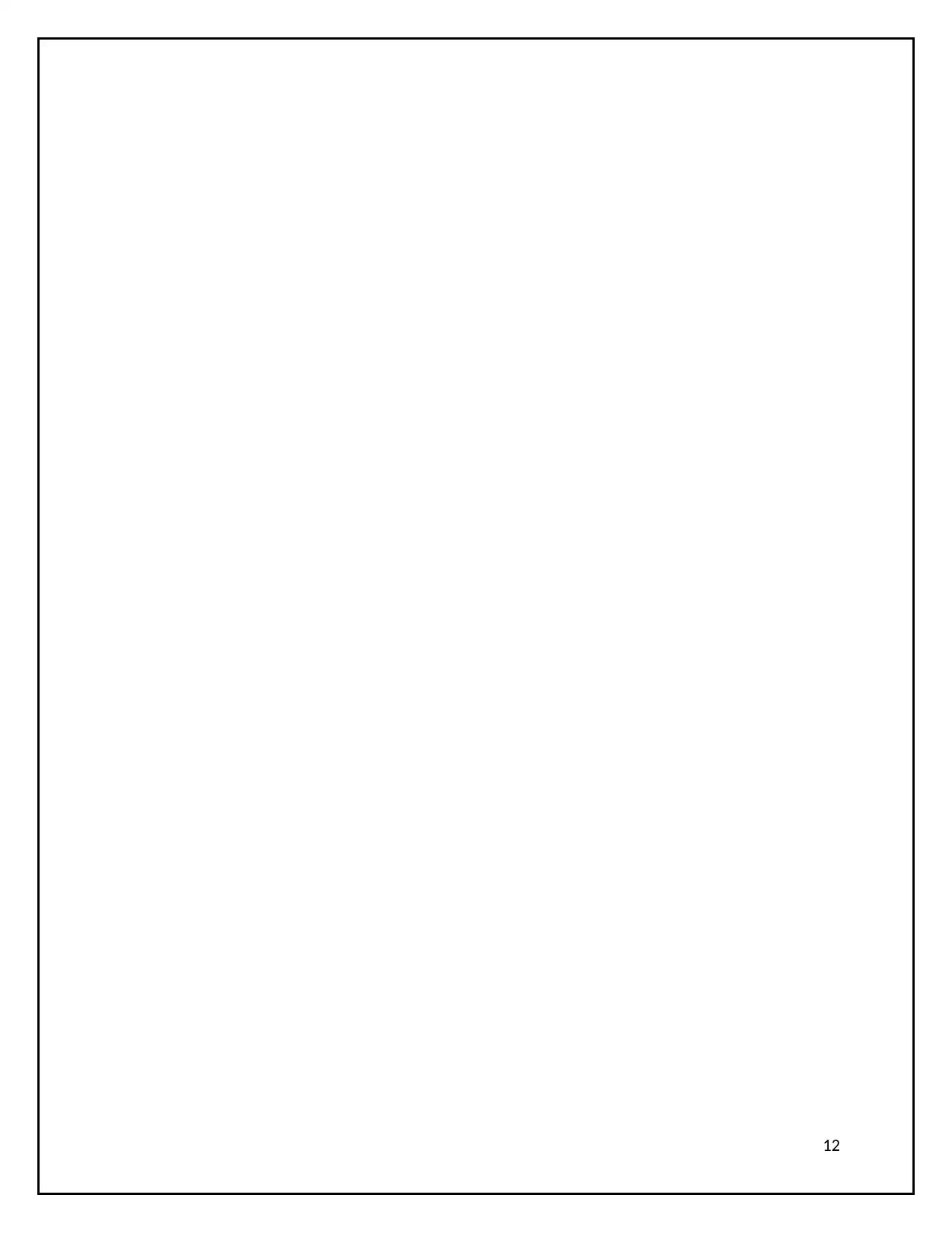
12
1 out of 12
Related Documents
Your All-in-One AI-Powered Toolkit for Academic Success.
+13062052269
info@desklib.com
Available 24*7 on WhatsApp / Email
![[object Object]](/_next/static/media/star-bottom.7253800d.svg)
Unlock your academic potential
© 2024 | Zucol Services PVT LTD | All rights reserved.





